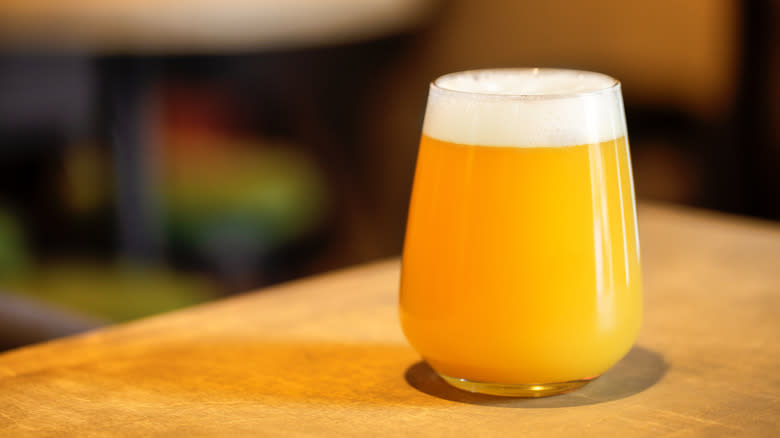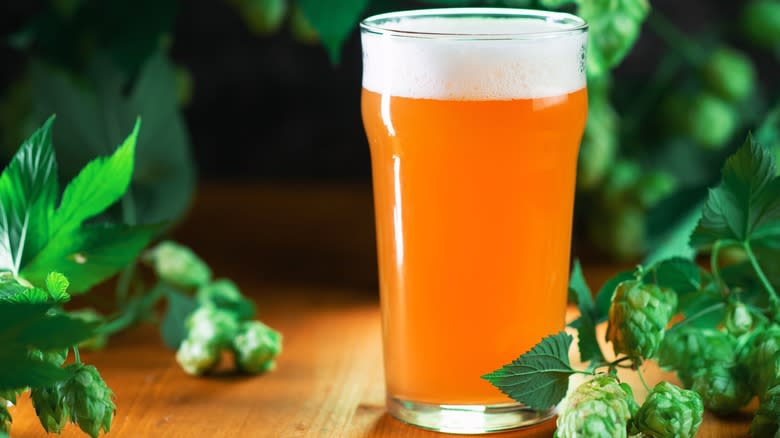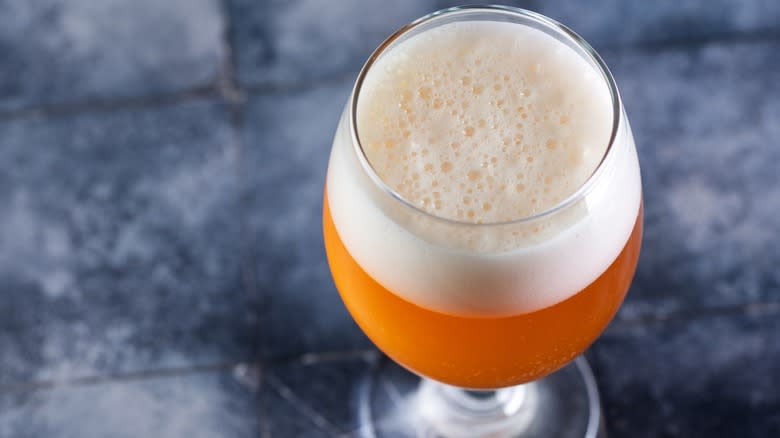What Makes An IPA Hazy?

If you're not a particularly experienced beer drinker, but you're often surrounded by folks who are, the conversation can probably lose you pretty quickly. From chatter about hazy boys and crispy boys to Citra and Cascade; IPAs, stouts, and pilsners (oh my) -- it can be overwhelming to discuss beer. There's a ton of jargon, not to mention informal slang terms, and it all can seem impenetrable to the uninitiated. But since hazy IPAs are wildly popular these days, it's as good a place as any to start decoding beer lingo.
You might already know that IPA stands for India Pale Ale, a British style of beer dating back to the late 18th century (more on that later). And if you've ever sipped one from a clear glass, you know the "hazy" description is pretty self-evident. Most light-to-medium colored beers are pretty translucent, with light able to shine through easily. But a hazy IPA, by contrast, has a cloudy appearance, looking fairly opaque when poured into a glass.
Hazy IPAs, also commonly known as New England or Northeast IPAs (NEIPAs), get their less-translucent appearance from using high protein grains in the brewing process, resulting in suspended solid particles throughout the liquid which are not filtered out before serving. Hazy beers tend to have a richer mouthfeel, feeling a little bit heavier on the palate than thinner, filtered beers typically do; and in terms of flavor, they're usually fruity and juicy, with well-balanced bitterness.
Read more: 10 Of The Healthiest Beers You Can Drink
You And I(PA)

Every beer is made from, at its core, four ingredients: malt, water, yeast, and hops. But beer is also a web of taxonomy, with hundreds of different recognized styles, the differences between some of which are minute. To understand the hazy IPA, it might be helpful to trace its genealogy a bit. While original India Pale Ales weren't as strong as one might think, they were developed at a time when British brewers realized that a high hop content helps preserve beers for longer. This helped make them able to withstand months-long journeys to British colonies in India and the Caribbean. But in addition to working as a preservative, hops impart a ton of varied, distinctive flavors into a beer, making the new export style an interesting variation on the classic pale ale.
The English-style IPA eventually birthed the American IPA, which typically leans heavily on hop varietals from the United States. American IPAs can be broken down into two main subcategories: West Coast IPAs and New England IPAs. West Coast-style IPAs tend to be clear, deep amber-colored beers with strong pine, floral, and skunky notes. If you've ever had an IPA and thought it tasted like liquid forest, it was probably a West Coast IPA. NEIPAs, East Coast IPAs, or hazy IPAs (all of which are more or less the same thing, just marketed differently) use a significant amount of high-protein grains like oats and wheat as the malt, which leads to a hazy appearance.
Orange Haze

The use of hops is super important to any IPA, and in the case of the NEIPA, the key is to add them late in the brewing process (also called dry-hopping) so that the flavors end up tasting very pronounced and distinctive. NEIPAs tend to utilize hops that carry fruity, juicy flavors, sometimes tasting uncannily like tropical or citrus fruits (which is further emphasized by the finished beer's orange juice-like appearance). Even if you can't stand the piney, dank flavors of West Coast-style IPAs, you might be a huge fan of NEIPAs — they're just that distinct from one another.
So while the difference between hazy IPAs and other kinds of American IPAs might seem technical, those tweaks in grain composition and hop usage result in a beverage that looks and tastes completely different. All IPAs have some degree of bitterness to them, but the fuller mouthfeel and bold fruity flavors tend to make NEIPAs taste a little more balanced and less aggressive.
One small warning, however: They may taste like fruit juice, but NEIPAs tend to have a slightly higher alcohol content than comparable styles. A good hazy IPA should be a delicious, easy sipper — just be sure to pace yourself.
Read the original article on Daily Meal.

